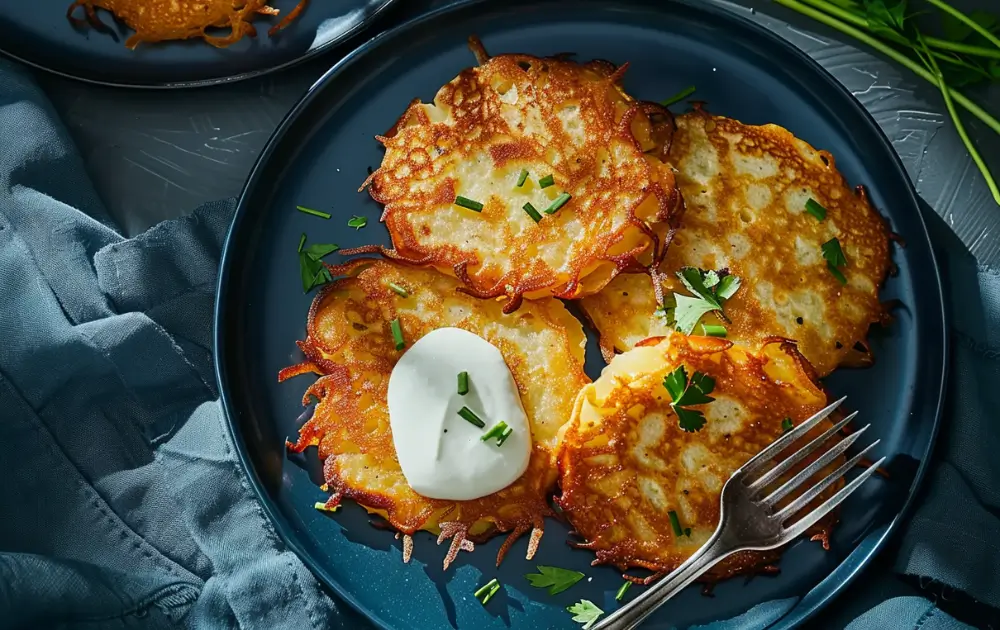Introduction to German Potato Pancakes
German Potato Pancakes, known as Kartoffelpuffer, are a beloved traditional dish enjoyed in many parts of Germany, especially during festivals and holidays. These crispy, savory pancakes are made with simple, hearty ingredients including shredded potatoes, eggs, flour, and onions. Seasoned with just salt and pepper, these pancakes are fried until golden brown, offering a deliciously crispy exterior with a soft, tender interior. They can be served with a variety of accompaniments such as applesauce, sour cream, or a sprinkle of sugar.
Selecting and Preparing the Ingredients
For the best results, choose medium-sized potatoes that are high in starch like Russets or Yukon Golds; these varieties help the pancakes hold together and achieve a desirable crispness. Begin by peeling the potatoes, then shredding them using a box grater or food processor. It’s important to squeeze out as much moisture as possible from the shredded potatoes to prevent soggy pancakes. Mix the shredded potatoes with finely chopped onions, adding texture and a slight sweetness that complements the savory notes of the pancakes.
Creating the Batter
To prepare the batter for the pancakes, beat the eggs in a large bowl until they are smooth. Add all-purpose flour, baking powder, salt, and pepper to the beaten eggs, creating a mixture that will help bind the potatoes and onions together. Stir in the shredded potato and onion mixture until everything is well coated with the batter. This ensures that each pancake will have a consistent flavor and texture, with the baking powder providing a slight lift to make them a bit fluffier.
Cooking the Pancakes
Heat vegetable oil in a large skillet over medium-high heat. The oil should be hot enough that it sizzles when a small amount of batter is dropped into it. Spoon the potato mixture into the hot oil, flattening the mounds with the back of the spoon to form pancakes. Fry each pancake until the edges are crisp and golden brown, then flip to cook the other side. It’s important to not overcrowd the skillet, as this can reduce the temperature of the oil and result in less crispy pancakes.
Serving Suggestions
German Potato Pancakes are versatile and can be enjoyed in many different ways. Traditionally, they are served with applesauce or sour cream on the side, which provides a creamy or sweet counterbalance to the savory, salty flavor of the pancakes. For a more modern twist, try serving them with smoked salmon and a dollop of crème fraîche, or alongside a green salad for a light, balanced meal. Whether as a side dish, appetizer, or the main course, these potato pancakes are sure to be a hit.
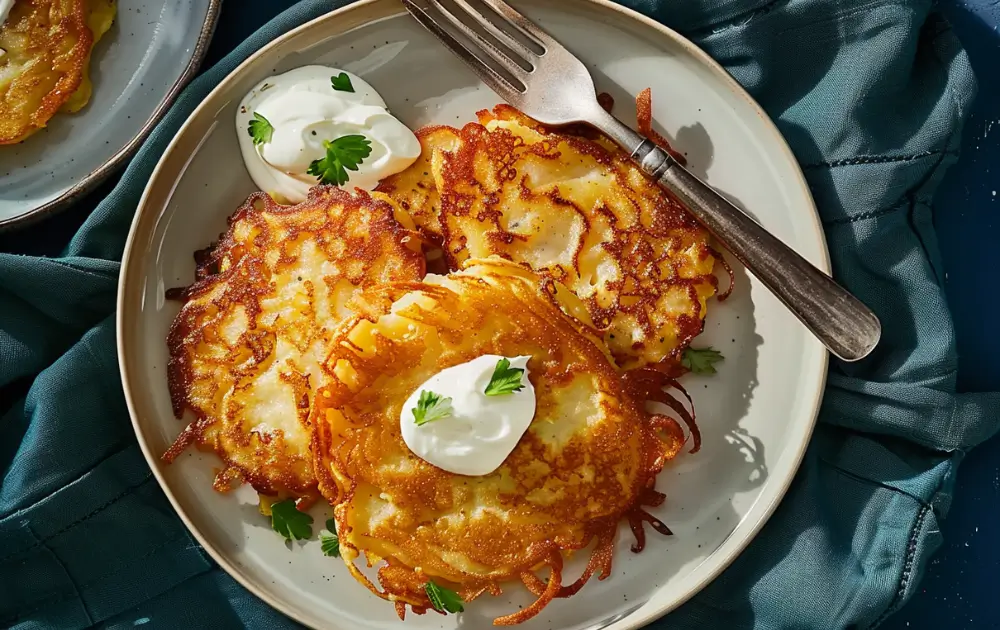
Enhancing Flavor with Additional Ingredients
While traditional German Potato Pancakes are simple and delicious, adding extra ingredients can elevate the flavor and texture. Consider incorporating grated carrots or zucchini into the potato mixture for added color and a nutritional boost. For those who enjoy a bit of heat, minced jalapeños or a dash of cayenne pepper can be mixed into the batter. A small amount of grated cheese such as sharp cheddar or Gruyère can also be added for a melty, savory element in each bite. These additions not only enhance the taste but also allow for customization to suit different palates.
Dietary Adaptations
To accommodate various dietary needs, modifications can be made to the traditional recipe. For a gluten-free version, substitute the all-purpose flour with a gluten-free flour blend. For those watching their caloric intake, consider using less oil by opting for a non-stick skillet or cooking spray instead of frying in a lot of vegetable oil. Additionally, the eggs can be replaced with an egg substitute or simply omitted to bind the ingredients with a little more flour or potato starch for those avoiding eggs.
Cooking Techniques for Perfect Crispiness
Achieving the perfect crispiness in German Potato Pancakes involves a few key cooking techniques. Ensure the oil in the skillet is hot enough before adding the batter; this helps to seal the exterior quickly, keeping the insides soft while the outside becomes crispy. The pancakes should be spread thinly in the pan to maximize the surface area in contact with the heat, which enhances the crisp texture. After frying, place the pancakes on a paper towel-lined plate to absorb any excess oil, which helps maintain their crispiness.
Event Serving Ideas
German Potato Pancakes are a great addition to any event menu, from casual gatherings to more formal parties. For a buffet-style setting, keep them warm on a lined baking sheet in a low-temperature oven so guests can enjoy them crispy throughout the event. Serve alongside a variety of toppings and sauces, such as traditional applesauce, rich sour cream, or a savory garlic aioli, allowing guests to customize their pancakes. For smaller, sit-down meals, consider serving them as an appetizer with a light arugula salad or as a side dish to complement main courses like roasted meats or hearty stews.
Storage and Reheating Tips
To store leftover German Potato Pancakes, allow them to cool completely before placing them in an airtight container. They can be refrigerated for up to three days. For reheating, place them on a baking sheet in a preheated oven at 350 degrees Fahrenheit until they are hot and crispy again, typically about 10-15 minutes. This method helps to restore the texture better than microwaving, which can make them soggy. Freezing is also an option; freeze them in a single layer on a baking sheet before transferring to a freezer-safe bag, allowing you to enjoy fresh-tasting potato pancakes for weeks.
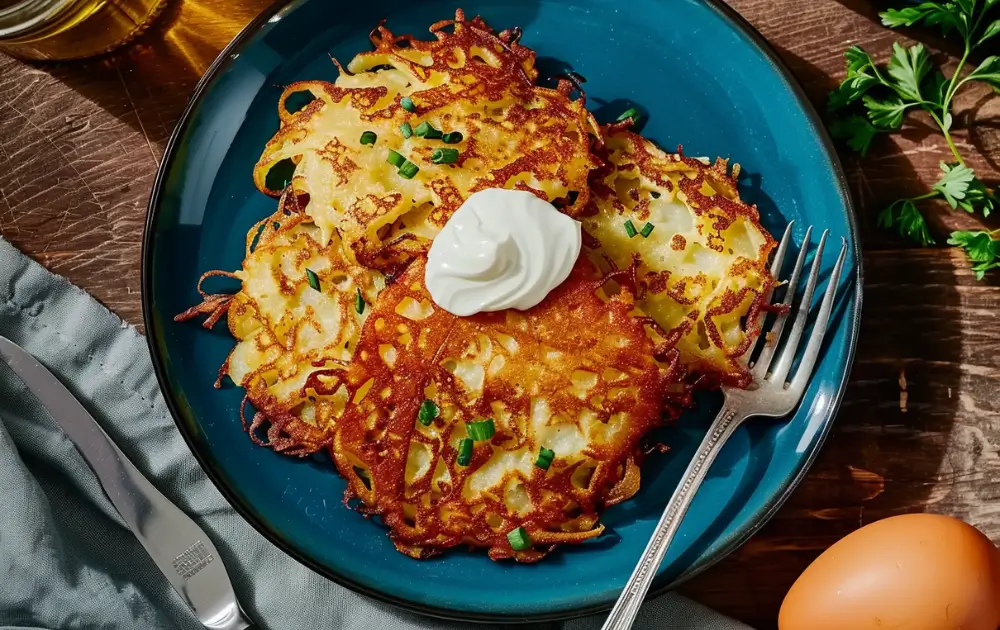
Exploring International Variations
Experiment with international variations of German Potato Pancakes to keep the menu exciting and diverse. For instance, add a Latin twist by incorporating spices like cumin and coriander, and serve with a side of guacamole or salsa for dipping. For an Asian flair, mix in some chopped scallions and sesame oil into the batter, and offer a soy sauce-based dipping sauce. Middle Eastern versions might include spices such as turmeric and cumin, paired with a side of yogurt or tahini sauce. These variations not only cater to diverse tastes but also introduce guests to different culinary traditions using a familiar format.
Utilizing Leftovers Creatively
German Potato Pancakes can be more than just a side or appetizer; they are also a creative way to utilize leftovers. If you have leftover mashed potatoes or other cooked vegetables, they can be easily incorporated into the pancake mixture. This not only reduces food waste but also adds new flavors and textures to the dish. For instance, mashed sweet potatoes can be used as part of the batter for a sweet-and-savory version, or leftover sautéed mushrooms can be added for an earthy flavor boost.
Hosting Interactive Cooking Classes
Offering interactive cooking classes focused on making German Potato Pancakes can be a great way to engage with the community or add value to a culinary business. During these classes, participants can learn the basics of selecting ingredients, mixing, and frying techniques, as well as how to serve and pair the pancakes with various condiments. Providing such classes not only educates people about a traditional German dish but also encourages them to cook at home, promoting a hands-on approach to learning about food and cooking.
Incorporating Healthy Ingredients
For health-conscious diners, adapting the recipe to include healthier ingredients can make German Potato Pancakes a more frequent menu choice. Using sweet potatoes instead of white potatoes adds a higher content of vitamins and fiber. Incorporating whole wheat flour or almond meal can provide a richer source of nutrients and lower the glycemic index than regular all-purpose flour. Additionally, using unsweetened applesauce or Greek yogurt as toppings instead of sour cream can decrease fat and calorie content while still providing creamy, satisfying flavor complements.
Seasonal Menu Integration
Integrating German Potato Pancakes into seasonal menus can attract diners looking for comforting, warm dishes especially in the colder months. During autumn and winter, offer these pancakes as part of a holiday menu, perhaps featuring them alongside hearty meats like sausages or pork, or as a part of a festive vegetarian spread. In the spring and summer, lighter versions can be served with fresh garden salads or alongside grilled vegetables, making them versatile enough to be a year-round favorite. This approach keeps the menu dynamic and responsive to customer preferences throughout the year.
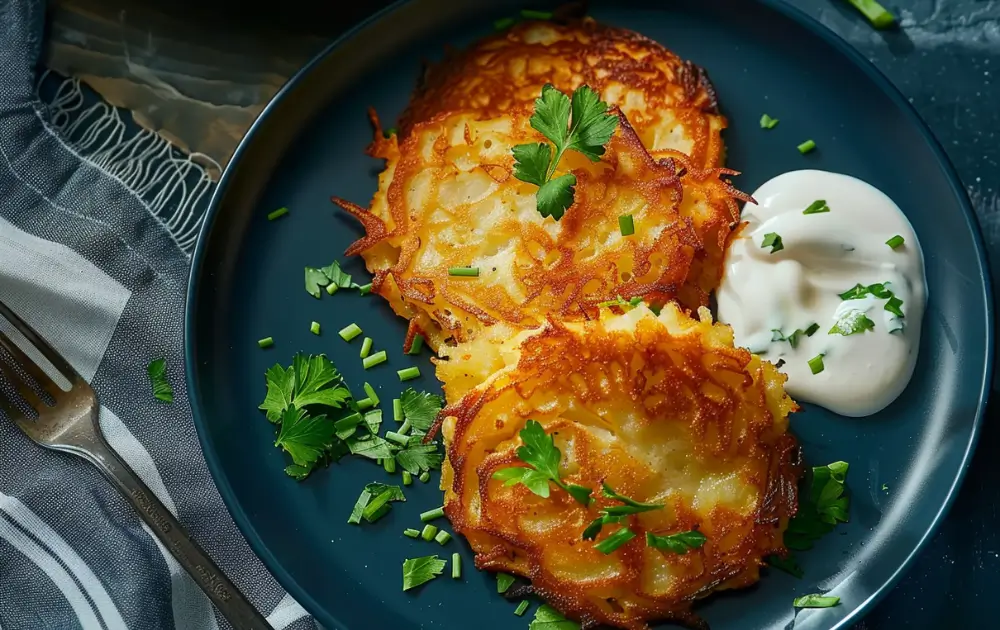
Enhancing Event Menus
German Potato Pancakes can enhance the menu at various events by serving as a versatile and appealing option for guests. Whether it’s a wedding, corporate event, or family reunion, offering these pancakes as a passed appetizer or part of a buffet can satisfy a wide range of tastes. Consider mini potato pancakes topped with sour cream and chives for a bite-sized appetizer or larger ones served with a selection of meats and cheeses for a more filling option. For themed events, they can be adapted to fit the occasion, such as adding unique toppings for holiday parties or using ingredients that match the event’s color scheme.
Marketing for Dietary Needs
Tailoring the German Potato Pancakes recipe to meet specific dietary needs can help attract a broader audience. Market these pancakes as a gluten-free option by substituting the flour with a gluten-free mix, appealing to guests with dietary restrictions. Offering vegan variations by using plant-based substitutes for eggs can also broaden their appeal. Highlighting these options in marketing materials can attract health-conscious consumers and those with specific dietary preferences, helping your menu stand out in a competitive dining landscape.
Pairing with Beverages
Proper beverage pairing can elevate the dining experience of enjoying German Potato Pancakes. For a traditional pairing, offer a selection of German beers, which complement the savory notes of the pancakes. Light, crisp white wines such as Riesling or Grüner Veltliner also pair beautifully, balancing the richness of the pancakes with their refreshing acidity. For non-alcoholic options, craft a selection of artisanal sodas or infused waters that enhance the flavors without overpowering them, ensuring there’s something for everyone at your table.
Seasonal Promotion Strategies
Utilize seasonal promotion strategies to boost the popularity of German Potato Pancakes throughout the year. During fall and winter, promote them as a comforting, warm dish ideal for chilly weather. In the spring and summer, highlight how they can be lightened up with fresh, seasonal toppings like herbs and vegetables. Offering limited-time menu items featuring the pancakes with seasonal ingredients can create a sense of urgency and draw in customers looking for something new and exciting, increasing foot traffic and customer engagement.
Culinary Education and Storytelling
Incorporate culinary education and storytelling into your presentation of German Potato Pancakes to enhance the dining experience. Share the cultural history and traditional aspects of the dish through menu descriptions, tableside presentations, or social media content. Educating diners about the origins of the pancakes and how they are traditionally made and served in Germany can enrich the meal, turning it into an educational experience that might inspire appreciation and curiosity about German cuisine. This approach not only adds depth to the dining experience but also helps build a connection between the food and its cultural roots.
Frequently Asked Questions about German Potato Pancakes
- What are the best potatoes to use for German Potato Pancakes? For German Potato Pancakes, starchy potatoes like Russets are ideal because they help create a crispy texture on the outside while maintaining a soft interior.
- Can German Potato Pancakes be made ahead of time? Yes, you can prepare the batter ahead of time and refrigerate it for a few hours. However, for the best texture, it’s recommended to fry them just before serving.
- Are there any tricks to keep the pancakes from turning brown after shredding the potatoes? To prevent browning, place the shredded potatoes in cold water to remove excess starch and keep them submerged until ready to mix with other ingredients. Drain and pat them dry before using.
- What are the best toppings for German Potato Pancakes? Traditional toppings include applesauce, sour cream, or smoked salmon. For a savory twist, try topping them with crème fraîche and chives or a dollop of horseradish sauce.
- How can I ensure my potato pancakes are crispy? Make sure to squeeze out as much liquid as possible from the shredded potatoes. Also, frying them in enough hot oil and not overcrowding the pan are crucial steps to achieve a crispy texture.
Conclusion
German Potato Pancakes offer a delicious blend of simplicity and comfort, making them a versatile dish suitable for various dining occasions. Whether served as a hearty breakfast, a satisfying side, or a festive appetizer, these pancakes are a crowd-pleaser with their golden, crispy edges and tender middle. By experimenting with different toppings and incorporating dietary variations, you can cater to a wide range of tastes and preferences, ensuring everyone can enjoy this delightful dish. With their rich cultural background and delicious flavor, German Potato Pancakes are sure to remain a beloved choice in any culinary repertoire.
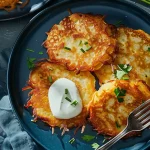
German Potato Pancakes
- Total Time: 45 minutes
- Yield: 10
- Diet: Vegetarian
Description
German Potato Pancakes, or Kartoffelpuffer, are a traditional German dish known for their crispy exterior and tender interior. Made from grated potatoes mixed with onion, eggs, and flour, these savory pancakes are fried until golden and typically served with applesauce or sour cream.
Ingredients
Instructions
Notes
- Ensure to remove as much moisture as possible from the potatoes to avoid soggy pancakes.
- Keep the cooked pancakes warm in an oven set to a low temperature while frying subsequent batches.
- Prep Time: 15 minutes
- Cook Time: 30 minutes
- Category: Side Dish
- Method: Frying
- Cuisine: German
Nutrition
- Calories: 150
- Sugar: 1g
- Fat: 7g
- Saturated Fat: 1g
- Carbohydrates: 18g
- Fiber: 2g
- Protein: 4g
- Cholesterol: 53mg

